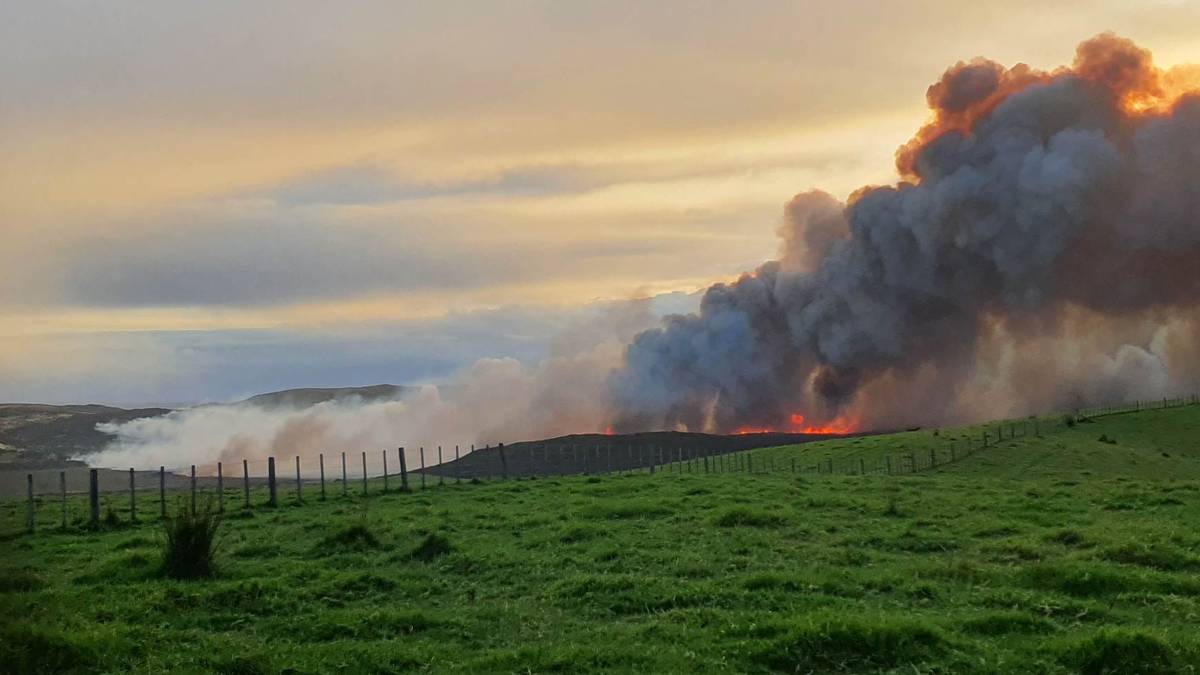The fire advances towards SH1 from Te Werahi Beach on Tuesday night, just south of Te Rerenga Wairua/Cape Rēinga. Photo / Ngāti Kuri
Firefighters using a combination of ground crews and helicopters are continuing to battle a large blaze threatening sites of huge cultural and ecological significance near Cape Rēinga.
As of 3pm on Wednesday the fire covered 390 hectares, significantly larger than the morning’s estimate of 160ha, and it was being fought by 10 helicopters with monsoon buckets and 24 firefighters on the ground.
State Highway 1 is expected to remain closed north of Te Paki Stream for some time, along with all walking tracks and campsites in the area.
The blaze, which was first spotted about 3.15pm on Tuesday, is just south of Te Rerenga Wairua/Cape Rēinga, between Te Werahi Beach and State Highway 1.
Advertisement
The popular Taputaputa campsite, just east of the cape, was evacuated on Tuesday evening and remains closed.
Fire and Emergency NZ incident controller Rory Renwick said Wednesday’s efforts were focused on preventing the fire from flaring and spreading north.
“Our expectation is that we’ll be able to continue to hold it. However, if it does get away, it will be hard to stop.”
Firefighting would have to stop at nightfall because it was unsafe to use helicopters or operate on foot on the difficult terrain after dark.
Advertisement
Four ground crews, comprising 24 firefighters from as far away as Paparoa, had been “wetting down” the fire’s edges so he was hopeful it would not spread further overnight.
/cloudfront-ap-southeast-2.images.arcpublishing.com/nzme/A4CZMLDJWJAMXJ3YHYOXBYCM4U.jpg)
Firefighting would resume at first light with more people on the ground, around 40, but fewer helicopters.
The wind was forecast to remain strong on Thursday but the direction, southeasterly rather than southwesterly, would be a little more favourable.
That increased the risk the fire would spread towards the iconic Cape Rēinga lighthouse, but reduced the chance of it burning all the way to the top of the peninsula.
It was too early to know what had caused the fire but it appeared to have started between Te Werahi and Twilight, he said.
“It’s a good warning to people that even though we’re not in a drought, scrub is very flammable any time it’s not raining or there’s a bit of wind.”
Local iwi Ngāti Kuri urged people not to travel north of Te Paki Stream, both for safety reasons and to allow emergency services to fight the fire unhindered.
The iwi also advised that all walking tracks between Kahokawa/Scott’s Pt — the northernmost point of Te Oneroa a Tōhē/Ninety Mile Beach — and Kapowairua/Spirits Bay had been closed until further notice.
That included Te Werahi Loop Track, also known as Twilight Track, off SH1 and all “micro campings” along Te Paki Coastal Track.
/cloudfront-ap-southeast-2.images.arcpublishing.com/nzme/X7KMPNNRRZE5HFXATFZ53FOSIE.jpg)
Ngāti Kuri Trust Board director Sheridan Waitai said the alarm was first raised by a Ngāti Kuri taiao (environmental) worker.
Advertisement
If a helicopter had been sent immediately, when he said it was needed, the fire might have been put out long ago.
Instead, the order for a chopper had to come through a government agency, delaying the response, she said.
Waitai said the iwi was helping with logistics such as transporting helicopter fuel and traffic control, as well as keeping a 24-hour watch on the fire.
Manuhiri (guests) staying at Taputaputa campground were evacuated when it was feared the fire could cross the access road and make it impossible for them to get out.
They had been moved to campgrounds further south at Rarawa Beach and Ngapae, she said.
The fire was “absolutely devastating” because it was in an area where the iwi was working to protect a rare snail, a taonga species called pūpū whakarongotaua which had played an important role in tribal history.
Advertisement
Only about 1000 pūpū whakarongotaua remained, and of those only about 300 were capable of breeding, Waitai said.
Te Paki Ecological District, which includes Te Rerenga Wairua/Cape Rēinga, is nationally significant for its conservation and ecological values. It also has many archaeological sites.
The fire is on a mix of conservation and private land covered mainly in dense mānuka.



